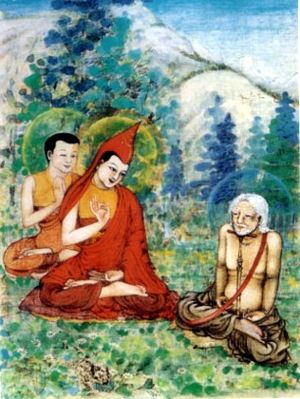Space category: Difference between revisions
Jump to navigation
Jump to search
mNo edit summary |
No edit summary |
||
| Line 1: | Line 1: | ||
'''Space category''' (Tib. ''Longdé''; [[Wyl.]] ''klong sde'') — one of the [[three categories]] into which [[Mañjushrimitra]] divided the [[Dzogchen]] teachings he received from [[Garab Dorje]]. | [[Image:Vairotsana Mipham.jpg|thumb|'''[[Vairotsana]] instructing [[Pang Mipham Gönpo]]''' from a painting by [[Dugu Choegyal Rinpoche]]]]'''Space category''' (Tib. ''Longdé''; [[Wyl.]] ''klong sde'') — one of the [[three categories]] into which [[Mañjushrimitra]] divided the [[Dzogchen]] teachings he received from [[Garab Dorje]]. | ||
The root [[tantra]] of Longdé is called 'Longchen Rabjam'. | The root [[tantra]] of Longdé is called 'Longchen Rabjam'. | ||
Revision as of 15:28, 1 August 2009

Space category (Tib. Longdé; Wyl. klong sde) — one of the three categories into which Mañjushrimitra divided the Dzogchen teachings he received from Garab Dorje.
The root tantra of Longdé is called 'Longchen Rabjam'.
Khenpo Namdrol says:
- Next, the inner category of space, the Longdé, is reckoned to consist of 20,000 ‘volumes.’ These can be classified into three: white space, black space, and variegated space, or they can also be categorized as nine spaces. From Shri Singha, Vairotsana received the Longdé pith instructions, and composed ‘the Vajra Bridge’, a scriptural text, which he transmitted in Tibet to Pang Sangyé Gönpo. Pang Sangyé Gönpo and the six successive disciples in his lineage left this world by dissolving into a body of light.